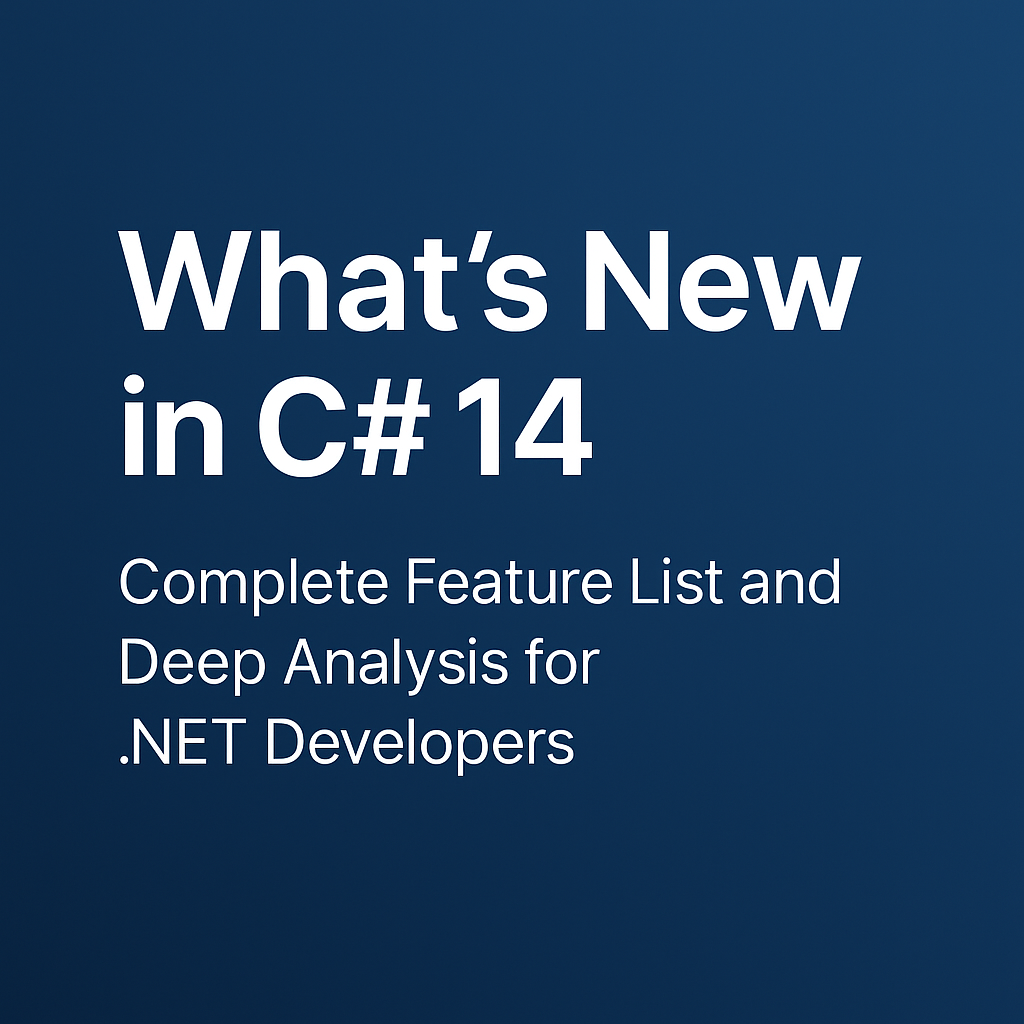This content originally appeared on Level Up Coding - Medium and was authored by Juan Andrés Leiva
What’s New in C# 14: Complete Feature List and Deep Analysis for .NET Developers
Introduction
C# 14 arrives with .NET 10 as a focused release. No headline-grabbing “records” or “async/await” moments — but a set of improvements that sharpen the developer experience and optimize the language for modern workloads.
The standout? Extension members, a feature that redefines how we extend existing types. Alongside that, improvements to spans, null-conditional assignment, and DTO handling bring real productivity and performance gains.
Note: Keep in mind this list might change before the actual release, scheduled to happen on November 2025.


Full List of C# 14 Features
- Extension members (properties, static members, operators)
- Null-conditional assignment (?. and ?[] on the left-hand side)
- nameof supports unbound generics (nameof(List<>))
- First-class Span<T> and ReadOnlySpan<T> conversions
- Parameter modifiers on simple lambda parameters (out, ref, in, scoped)
- field-backed properties (field keyword replaces explicit backing fields)
- Partial constructors and partial events
- User-defined compound assignment operators (e.g., += for value objects)
Extension Members — The Headline Change in C# 14
For years, C# has let us add extension methods. With C# 14, we can now extend types with properties, static members, and operators inside extension blocks.
Example: Extending string
public static class StringExtensions
{
extension(string s)
{
// Extension property
public bool IsCapitalized =>
!string.IsNullOrEmpty(s) && char.IsUpper(s[0]);
// Extension method (for comparison)
public string Repeat(int times) => string.Concat(Enumerable.Repeat(s, times));
}
extension(string)
{
// Static-like extension member
public static string EmptyIfNull(string? value) => value ?? string.Empty;
}
}
// Usage
var word = "Hello";
Console.WriteLine(word.IsCapitalized); // true
Console.WriteLine(word.Repeat(3)); // HelloHelloHello
Console.WriteLine(string.EmptyIfNull(null)); // ""
Here you can see:
- An extension property (IsCapitalized).
- An extension method (Repeat) for context.
- A static extension member (EmptyIfNull).
All feel like they naturally belong to string.
This adds discoverability. Instead of hiding helpers in static classes, conventions are visible in IntelliSense right on the type.
On top of that, it promotes cleaner APIs. Domain rules like Money.Total or conventions like HttpRequest.IsJson read like native members.
All in all, it means an architectural shift. This is the closest C# has come to mixins, and it changes how libraries and teams will structure code going forward.
Risks and Pitfalls
- IntelliSense overload: Without discipline, every type can become a dumping ground of pseudo-members.
- Ambiguity: If two libraries define the same extension property, the compiler picks based on using.
- Operator abuse: Extending operators onto types you don’t own can make code less clear.
Real-World Impact
Extension members are the biggest design shift in C# 14. Libraries will start to package extension modules instead of static helpers. Teams should set conventions early:
- What belongs as an extension member?
- How should they be grouped?
- Which layers (web, domain, infra) are allowed to define them?
Handled well, extension members make code expressive and discoverable.
Null-Conditional Assignment
You can now assign through ?. or ?[].
user?.LastSeenAt = DateTimeOffset.UtcNow;
cart?.Items?[index] = item;
This potentially removes endless null-check boilerplate in controllers and DTO mappers. But it can mask real bugs, for example if user should never be null, this syntax hides the problem.
This change could be great for hydration and optional data flows; dangerous for invariants. Teams should enforce clear rules in reviews.
Span Conversions
C# 14 makes Span<T> and ReadOnlySpan<T> conversions implicit and smoother.
ReadOnlySpan<byte> prefix = "API-"u8;
if (key.StartsWith(prefix)) { … }
In web apps, where we spend lots of CPU on string/byte handling (headers, tokens, routes). Spans cut allocations and GC pressure.
Just be aware of the Breaking Change in Overload Resolution. C# 14 expands type inference rules for methods accepting ReadOnlySpan<T> or Span<T> parameters, making them applicable as extension methods in more scenarios, including directly on arrays.
field-Backed Properties
public string Slug
{
get;
set => field = value.Trim().ToLowerInvariant();
}
This is perfect for DTO normalization and ASP.NET Core options binding. No explicit private field needed.
Other Features at a Glance
- nameof unbound generics: Niche, useful in analyzers and source generators.
- Lambda parameter modifiers: Cleaner TryParse delegates.
- Partial constructors/events: Unlocks scenarios for source generators. You won’t write them directly.
- User-defined compound assignment: Handy for value objects (Money, Units). Rare in everyday web code.
Annex: How to Use C# 14 Today
1. Install the .NET 10 SDK
Download the latest SDK for your OS from the official .NET downloads page. Verify:
dotnet --version
You should see a 10.x.x version.
2. Create a Project
dotnet new webapi -n DemoCSharp14
cd DemoCSharp14
Note that I use webapi but feel free to use any other template that makes sense for you.
3. Target C# 14
In your .csproj:
<PropertyGroup>
<LangVersion>14.0</LangVersion>
</PropertyGroup>
If you’re using a preview SDK:
<PropertyGroup>
<LangVersion>preview</LangVersion>
</PropertyGroup>
4. Test a Feature
public class User
{
public string? Name { get; set; }
public int LoginCount { get; set; }
}
var user = new User { Name = "Alice" };
user?.LoginCount += 1;
Console.WriteLine(user.LoginCount); // 1
If it compiles, you’re running C# 14 (null -conditional assignment).
Further reading
Official docs for the C#14:
https://learn.microsoft.com/en-us/dotnet/csharp/whats-new/csharp-14

Juan Andrés Leiva
I write about .NET architecture, API design, and DevOps.
👉 Follow for deep technical dives and production-ready strategies.
💬 Share your thoughts or questions in the comments — I reply to all messages.
GitHub · LinkedIn · Medium
What’s New in C# 14: Complete Feature List and Deep Analysis for .NET Developers was originally published in Level Up Coding on Medium, where people are continuing the conversation by highlighting and responding to this story.
This content originally appeared on Level Up Coding - Medium and was authored by Juan Andrés Leiva
Juan Andrés Leiva | Sciencx (2025-09-22T14:57:50+00:00) What’s New in C# 14: Complete Feature List and Deep Analysis for .NET Developers. Retrieved from https://www.scien.cx/2025/09/22/whats-new-in-c-14-complete-feature-list-and-deep-analysis-for-net-developers/
Please log in to upload a file.
There are no updates yet.
Click the Upload button above to add an update.
